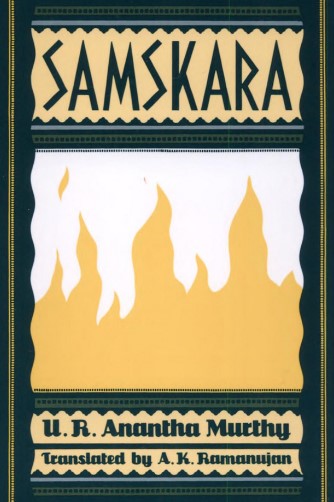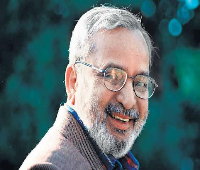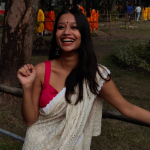REVIEWED BY YASHODHARA GUPTA
Originally published in the year 1965 in Kannada, Samskara: A Rite for a Dead Man marked the debut of U. R. Ananthamurthy into the literary world, one he would go on to make a strikingly unique mark in.
At first glance, this is a novel that dwells in the contemplative space, drawing questions from questions only to realize the inadequacies of fixity. As one reads further, though, Samskara gets personal. It shifts from theoretical analyses to a more tangible, bodily dilemma: how should a man live his life and how must he die?
The story, set in a small, traditional Brahmin village in Karnataka, centers upon the passing of Naranappa, a Brahmin man who defied social norms and led a ‘scandalous’ life. This is a man who has done as he pleased his entire life. In death, however, this audacious soul is at the mercy of the living. His Judgement Day conducts itself through a vocabulary of Brahministic order. The villagers too, find themselves conflicted, their moralities drawn into question. They must decide how the dead man treads into the afterlife. The final decision of who will carry out these last rites ends up falling onto the shoulders of Praneshacharya, considered pious and wise. As the burden of justice befalls him, the story pivots into a wholly personal journey for Praneshacharya: one that involves questioning the very order he has built his life upon.
The novel posits itself within a cross-section of various rural identities. At this complex intersection, it proposes the problematics of the stagnant culture that drives the life of Durvasapura’s people. This is a community rife with orthodox values of Brahminism, its beliefs cemented in ritual, and its power maintained by a systematic subjugation of the lower caste. The very life of the dead man, Naranappa, is a challenge to this rusting order. As the question of what to make of this life escapes the grounds of individual claim and settles into the air of the village, one recognizes that the simple act of living then dying has sown the seeds of a complete dismantling of hegemonic beliefs.
The lyrical and precise prose of Ananthamurthy captures the village’s cultural and religious construction. His incorporation of philosophical undertones and symbolism further invigorates the story built, drawing the readers in and engaging them in dilemmas that permeate into their own lives. The most striking part of the narrative is how alive the characters seem. They aren’t presented as mere types puppeteered by the author for the same of some superficial dialogue. They breathe, they think, they err, they grieve. Ananthamurthy imbues them with a sharp sense of personhood. And so we begin to care. To care deeply about their innermost fears, and the imminent disaster their ideologies seem headed toward. All at once, it feels as though we triumph with every little breakthrough, with every identification of violence as inflicted by the caste system. This is a novel that takes the idea of morality and holiness head-on, bringing out the fallacies in the arbitrary meanings we place in those words.
Samskara– that is the word that drives the story onward. It means many things, from ritual and preparation to rites of passage and transformation. And it’s interesting because the protagonist at hand seems so rigid, so sure of set ways, so unaware of how life takes on new meanings based on where one chooses to shine the light.
It is a beautifully written interaction between Chandri, a lower-caste woman who used to be the lover of the Naranappa, and Praneshacharya, convinced completely of the legitimacy of the Brahminical order, that seems to pulsate through the entire novel. It presents beautifully the resistance embodied in Chandri, the courage she has had to muster to come begging for her lover to die the right way. Her conversation with Praneshacharya has meant her stepping into a world that views her as innately impure, unclean, and inferior. And yet, she does not shy away from her demands. All at once, this conversation captures the unfairness of systems that have governed the lives of women such as Chandri, and the violating cruelty that they have so seamlessly sown into scriptural validity. This is a pivotal moment in Praneshacharya’s religious living, for it pushes the horizons of what he knows himself to be. It exposes his hypocrisies, the petty judgments that plague his so-called wisdom. It humanizes his body; it brutalizes his beliefs. Chandri, a woman of no consequence in a patriarchal world, is able to bring Praneshacharya’s astute Brahminism to its knees.
Praneshacharya is led thus to a journey of introspection and rediscovery. He steps out of the boundaries of this village, both physically and figuratively. We are not told where his travels land him, but we know that the right questions have sprung up. The question ultimately lands upon us. Do we ponder these dilemmas? Do we recognize them as part of our daily lives, our casual conversation, our perceptions of the world?
Samskara: A Rite for a Dead Man is a tapestry of the problematics that inch into our everyday, rendering us incapable of thought and action. It examines caste, class, and gender as it manifests in life and death. It is the story of one man’s rediscovery of what it means to holy. It is the story of a community that is faced with the need to look beyond, but bound in the inadequacies of prejudice. It is the story of a people, a nation, a land; the seeds of a change that must be birthed in the human soul.
Also, read Book Excerpt from No One as Rano Biswas by Alokparna, translated from The Bengali by Bishnupriya Chowdhuri and Published in The Antonym:




























0 Comments